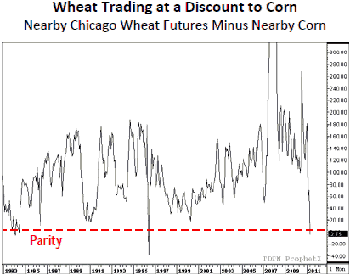



CME: Could Corn for Livestock Feeds be Rationed?
US - Rationing has been smaller than expected following the latest supply/demand figures, write Steve Meyer and Len Steiner. For cattle, they expect some substitution with wheat to take place more slowly than some others have predicted.The latest USDA supply/demand numbers did not change the projected ending stocks, opting to leave them at five per cent of total use even with smaller than expected March 1 stocks and indications that so far demand rationing has been smaller than expected.
Analysts and market participants concluded that USDA believes the five per cent stocks/use ratio implies minimum pipeline supplies and users will either limit purchases (due to higher prices) or shift to other inputs.
In the case of ethanol producers, there are no other economical input sources and as long as their margins stay in the black, they will continue to bid on corn supplies. Crude oil futures may have eased a bit but gasoline prices remain very firm and could support even higher corn prices. Also supportive of ethanol demand have been ethanol exports. High sugar prices have limited the use of cane for ethanol production in Brazil. Also, a strong Brazilian Real, high gasoline prices and strong domestic demand, has limited Brazilian ethanol shipments.


Much of the speculation in the market is that corn demand rationing will come from livestock and poultry production and, to a lesser extent, export markets.
In the case of corn used in growing and finishing rations, one alternative input is wheat. There have been many studies that have looked at the suitability of feeding wheat to cattle, both as part of backgrounding and finishing diets. In most cases, the studies focused on feeding damaged wheat, which normally trades at a discount and could be competitive with corn. But wheat vales have collapsed compared to corn in recent weeks (see chart above) and Chicago soft red winter wheat futures are currently trading at a discount to corn futures.
Referencing an extension publication from OSU (see table), Meyer and Steiner calculated the level at which wheat could be substituted for corn and soybean meal. The calculation is based on the assumption that 100 pounds of wheat replaces 92 pounds of corn and eight pounds of soybean meal. Based on the closes for corn ($7.555/bu) and soy meal ($342.2/ton) on 13 April, they calculate that SRW wheat could be used as a substitute up to a price of $8.27/bushel. Current wheat prices are well below that level and we are sure that some substitution already is taking place.
The question markets are asking is how much and unfortunately there will not be an answer on that until the June 1 stocks report comes out. It is important to keep in mind that a number of factors will limit substitution. It takes time to transition cattle into a ration that contains wheat. Some of the research we have seen recommends a transition period between 30 to 45 days. Wheat has a high starch content, which causes digestive problems in cattle. It is recommended that wheat make up no more than 30 to 50 per cent of the total diet. Feedlots are already using plenty of DDGs and we are not aware of studies that have looked at effectiveness of diets containing mostly wheat and DDGs but some of our readers likely have a good idea of that. Also some of the recommendations are that wheat needs to be included in the ration throughout the entire feeding period.
Bottom line: Some substitution will take place but likely not as quickly or as much as some think.








